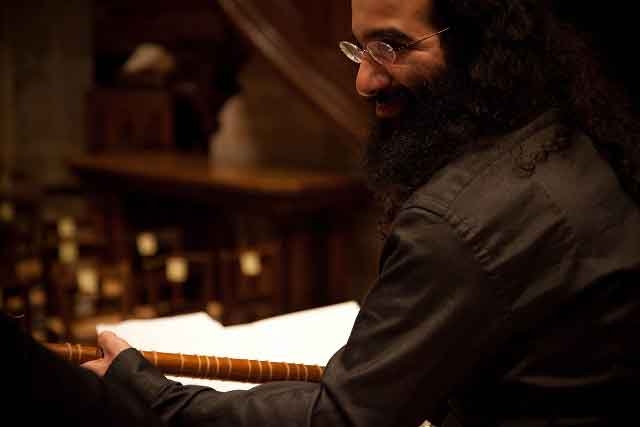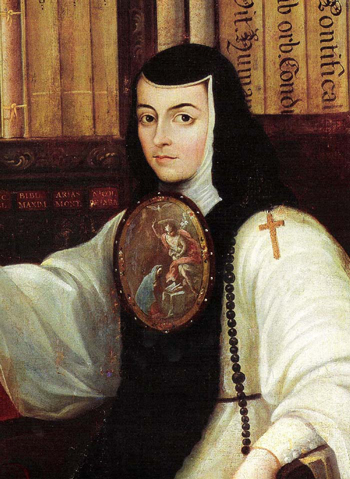Classical Perspectives
Constantinople’s Early Dreams: The Start Of a New Cycle
By Kiya Tabassian
Montréal, February 2011
Translation: Peter Christensen
©Kiya Tabassian
(Kiya Tabassian is the co-founder and artistic director of Constantinople, and plays setar with the group. His two essays on this page are from the liner booklet accompanying the group’s intriguing new Early Dreams album, which is available as a free downloaded pdf at the Analekta label’s website. In it Mr. Tabassian relates the backstory of Early Dreams, and offers a biographical sketch of the fascinating Sor Juana Inés de la Cruz [1648-1695], the self-taught scholar, poet, social activist, nun and major intellectual figure of her time ("the first great Latin American poetess," as Mr. Tabassian describes her below), whose poetry forms the text of the songs on Early Dreams. Sor Juana also composed music and was a talented vocalist, but her scores and compositions did not survive her. The music Constantinope makes on Early Dreams, centered on the ostinato bass lines of Spanish and Mexican diferencias from the Baroque era-Mexico, when the country was under Spanish rule, provides the exotic underpinning for Son Juana's words, which in turn are brought to life by the haunting vocals of France's Françoise Atlan.)The Early Dreams project represents both a return to the source and a rebirth for Constantinople. It is the start of a new cycle.
Constantinople was born ten years ago around a meeting of the sonorous musical and cultural worlds of two instruments--the setar and the European lute--the first, monodic and drawing melodic contours around the latter's bass lines and harmonic patterns. This dialogue was complemented by the virtuoso percussion work of Ziya Tabassian and the rich sound of the viola da gamba, which can take on the roles of both bass instrument and solo voice. Since its inception, the ensemble has travelled the world to explore new projects arising out of unique musical encounters between old manuscripts and living musical traditions. Driven by a constant desire to renew itself through creation, the group's projects draw from existing material while leaving room for informed improvisation.
Constantinople’s Kiya Tabassian: ‘The Early Dreams project represents both a return to the source and a rebirth for Constantinople.’This new cycle begins with Early Dreams, in which the setar, the Baroque guitar, percussion instruments and the viola da gamba mingle with the voice of our long-time collaborator Françoise Atlan over the ostinato bass lines of Spanish and Mexican diferencias from the Baroque era. We used these bass lines, drawn primarily from the works of Lucas Ruis de Ribayaz (c.1626-c.1667) and Santiago de Murcia (c.1682-c.1740), two Spanish instrumentalists and composers whose works were widely played in 17th- and 18th-century Mexico, as a starting point to recreate both instrumental and vocal works.
As part of this re-creation process, we immersed ourselves in the cultural essence of this promising New World and went to the heart of Baroque-era Mexico in search of what had fashioned the spirit of composers from the period: the fabric of the music, some written works, the grandeur of its cathedrals, and the treasures of its libraries.
Ensemble Constantinople, ‘Afuera, Afuera, Ansias Mas,’ based on a poem by Sor Juana Inés de la Cruz (1648-1695) and featured on the group’s new album, Early Dreams. Group members are: Kiya Tabassian, setar; Enrique Solinis, baroque guitar, FrançoiseAtlan, vocal; Pierre-Yves Martel, viola da gamba; Ziya Tabassian, percussion.The cultural context of Mexico of that time is fascinating. There is clearly a strong Spanish influence on the society, and as a result on the repertoire. Yet, Baroque Mexican culture stands out from its Spanish cousin by its religious and cultural syncretism. A major intellectual figure symbolizes the spirit of the entire period for both Mexico and Spain: Sor Juana Inés de la Cruz (1648-1695), the first great Latin American poetess.
We were overwhelmed by her impassioned poetry and texts, and the musicality of her writing made us want to bring it to life again.
A highly intellectual figure, Sor (sister) Juana Inés de la Cruz also composed music and was an undisputedly talented singer. However, her scores and compositions have not survived. To remedy this situation, we selected known bass lines of the period. As part of this (re)creation project, we teamed up with Canadian composer Michael Oesterle and invited him to write a piece. Sharing our fascination for the poetry and time of Sor Juana, he composed Tres sonetos, a very personal reading of this famous scholar's work.
Throughout this creative process, we kept an image of Sor Juana playing and singing her poems over these ostinato bass lines in our hearts. Françoise Atlan, performing Baroque repertoire for the first time, lends her warm and unique voice to the project. Actively involved in the creative process and a veritable restorer of a flamboyant past, she devoted her remarkable talent to the service of this key literary and intellectual figure's poems. The virtuosic dialogues between the Baroque guitar, the Persian setar, the viola da gamba and the percussion instruments also recreate a unique sound, one that is characteristic of our group. It's a sound that is both ancient and modern, tinged with Mediterranean and Mideastern sonorities, this time with a daring gaze toward the New World, nourished with respect and admiration for one of the most celebrated women scholars of New Spain, Sor Juana Inés de la Cruz.
Sources:
Lucas Ruis Ribayaz: Luz y norte musicale,
Madrid 1677Santiago de Murcia: Códex Saldívar no4,
Mexico 1732Gaspar Sanz: Instrucción de música sobre
la guitarra española, Zaragoça 1674Sor Juana Inés de la Cruz: Obras completas: Vols. I al IV. Toda la obra
***
Rising up against prejudice
Sor Juana Inés de la Cruz
‘It is moving to hear a voice in the struggle for liberty--a voice snuffed out by its suffocating era--sing out once again over the span of the centuries.’
The life of Sor Juana is relatively well known in spite of the normal uncertainties given the three centuries and the geographical distance separating her time and place from our own. Our modern fascination with Sor Juana could be explained by the uniqueness of her personality--an indispensable source of information is her biography written by the Mexican man of letters and diplomat Octavio Paz (1941-1998), winner of the Nobel Prize for literature in 1990. However, the primary source remains Sor Inés' own autobiography, entitled Respuesta a Sor Filotea (Reply to Sister Filotea), published in 1691, and virulently criticized in intellectual circles.
Juana Inés de Asbaje y Ramírez de Santillana, who was born in San Miguel Nepantla, in Mexico (New Spain at the time), in 1651 (some researchers say 1648) and died in Mexico City in 1695, seems to have been the illegitimate daughter of an adventurer who never admitted his paternity and a landed woman who never married. In a world where women were not allowed access to knowledge, and in particular a formal education, the young Inés demonstrated spectacularly precocious intellectual gifts (she wrote her first text at the age of seven) and rose up against prejudice by devising a scheme to disguise herself as a man in order to attend university. Although her plan failed, her mother sent her to Mexico City in 1664, and her remarkable talents eventually drew the attention of the court of Marquis de Mancera, Viceroy of Mexico, who was charmed by this rare instance, for the time, of a female poet, and one with such a sweet and likable nature. She soon became a lady-in-waiting of the viceroy's wife and proved to be just as brilliant in philosophy, theology, mathematics and astronomy, not to mention music, as she was in literature. She wrote with great relish, setting down poems, plays and texts to be sung at church-the popular villancicos so typical of Spanish music and essential components of the Empire's great religious feasts. Her only interest being in the arts and sciences, Juana knew full well that the monastic world would allow her to dedicate herself entirely to these pursuits. Her first attempt to enter a Carmelite convent failed, but in 1669, she was successful and turned her back on the lavish court life and took the veil, becoming Sor Juana Inés de la Cruz at the monastery of Jeronimas de Puebla, where she continued to write and fascinate her compatriots throughout the world. At the monastery, Sor Inés was free to develop her immense intelligence and devote herself to her love of literature.
Constantinople, ‘Détente, Sombra de Mi Bien Esquivo,’ from a poem by Sor Juana Ines de la Cruz, and featured on the group’s Early Dreams album. Vocal by Françoise Atlan.What makes her œuvre so interesting is undoubtedly the numerous perspectives under which she is considered. Some see her as the ultimate expression of a certain Spanish classicism, others as incarnating the first expression of a true American identity. There are convincing justifications for either interpretation. Hence, her poem "Primer Sueño" (Early Dream), which describes the dreamlike voyages of the human soul, falls into a tradition of Spanish literature whose most obvious representative is Luis de Góngora (1561-1627), while her plays cannot but display her admiration for Calderón. But as Octavio Paz writes, numerous works, including "Primer Sueño," are influenced by the Hermetic, mystical tradition of the Jesuit Athanasius Kircher. The polemics arising from her Reply to Sister Filotea clearly illustrate the problems raised by the existence of such a brilliant woman. A response to a letter attacking her for her focus on literature and the sciences and suggesting that she instead concentrate on theology, Sor Inés' Reply is a remarkable text on the recognition of women in society of the day. It also takes a run at the inordinate power of the Inquisition, a sign that her personality, so highly appreciated by her contemporaries, also had an opinionated and determined side. Defending the place of women in society, Sor Inés was also a fervent advocate of other victims of social prejudice: She viewed prostitutes with a sympathetic regard and was also among the voices standing up for black slaves and aboriginals in Spanish territories. However, the Reply attracted the wrath of the Archbishop of Mexico, who condemned Sor Juana's "waywardness." She resolved to stop writing rather than submit to censure.
In the end, only a small portion of Sor Inés' œuvre, collected today under the title Complete Works, has survived, a quarter of it consisting of religious songs. Legend has it that her writings were saved by the Mexican viceroy's wife herself, evidence that Sor Inés' unique voice had echoed deeply among her entourage. Similarly, we now know that her texts were set to music for over a century (until the 1780s) by the most important composers of South America, though her poetry was "adapted" to local practices. It is moving to hear a voice in the struggle for liberty--a voice snuffed out by its suffocating era--sing out once again over the span of the centuries.
©Kiya Tabassian
Translation: Peter Christensen
***
The Critical Perspective
‘…instead of a dutiful, musty revival of this era, the musicians here add sounds and textures from the Mediterranean, the Middle East and beyond.’
Album of the Week, WQXR-FM, New York City
Cinco de Mayo is all about celebrating. It marks the day in 1862 when Mexico defeated the French army in the Battle of Puebla. It's also an excuse to bring out lots of the Mexican music, and we don't mean just Mariachi and Norteña music.
The Montreal early-music ensemble Constantipole offers something different on Early Dreams, a collection of music by the Spanish composers whose works were popular in 17th- and 18th-century Mexico. But instead of a dutiful, musty revival of this era, the musicians here add sounds and textures from the Mediterranean, the Middle East and beyond.
Constantinople is no stranger to cultural cross-pollination. Founded in 1998 by Kiya Tabassian, an Iranian-born performer on the setar (a Persian lute with a long, rounded neck), the ensemble also includes his percussionist brother, Ziya Tabassian, and Pierre-Yves Martel, a viola da gamba player. Guests regularly fill out the ranks, in this case Enrique Solinis, a Spanish baroque guitarist, and Françoise Atlan, a French singer and musicologist who lives in Morocco.
The group’s wildly eclectic and exotic approach is heard throughout this collection. Santiago de Murcia’s "Marionas" is richly embellished with percussion and setar filigree, sounding more than a little like strains of ‘60s psychedelic folk. Strong Arabic influences are found in Lucas Ruiz Ribadayaz’s "Premiers Songes" as well as his "Las Fuentes Mi Voz Socorran," with its intricate vocal lines. Atlan’s clear and warm voice is displayed to particularly great effect in "La Petenera/La Serena," a sultry flamenco-tinged song. Several numbers also feature texts by Latin America's first major poet, Sor Juana Ines de la Cruz (1648-1695), including de Murcia's infectious "Afuera, Afuera, Ansias Mias."
Constantinople’s Early Dreams is available at www.amazon.com
More information about Constantinople and album downloads are available at the Analekta website.
Founder/Publisher/Editor: David McGee
Contributing Editors: Billy Altman, Laura Fissinger, Christopher Hill, Derk Richardson
Logo Design: John Mendelsohn (www.johnmendelsohn.com)
Website Design: Kieran McGee (www.kieranmcgee.com)
Staff Photographers: Audrey Harrod (Louisville, KY; www.flickr.com/audreyharrod), Alicia Zappier (New York)
E-mail: thebluegrassspecial@gmail.com
Mailing Address: David McGee, 201 W. 85 St.—5B, New York, NY 10024






